Riverboats, Brazil to Peru
September 2009 Update Manaus Brazil to Cajamarca Peru
Carol had a days rest from navigating a big city as Joelmir escorted us to the bustling wharves of Manaus. Two in a row for her, as Cecilias GPS gave her a holiday in Belem as well. Competing with cars, trucks, motorbikes, pushbikes and pedestrians in 40+C heat is not fun but having someone who knows the way up front makes it much easier.

That will NOT fit. Loading the bike at Manaus
Our boat, the Navio Sagrado Coracao de Jesus was moored some distance from the ticket sellers at a secured part of the docks. After instructions from Joalmir, we said our goodbyes and rode to the docks. Close to our vessel we were approached by four men offering their assistance to load our bike onto the boat. We had been informed however that the crew working on our ferry would take care of this so we displayed complete disinterest in them and their offer. Closer to the boat the men became very insistent despite our words of não é necessário (not necessary) to the point of being quite rude. We approached a man who appeared to be controlling the cargo and asked about the loading procedure. He advised that the gentlemen who were pushing to load the bike required the sum of (Brazilian Reals) BRL100 to do the job. We laughed and walked away. It appears the workers employed to load the boat appreciate the offer from our very aggressive dock workers as it is one less task they need to do.
The bike was moved by our demanding friends to a place closer to the boat ready for loading and there it sat for some hours as cargo was loaded onto the lower deck. We watched as the tons of cargo pushed the vessel so low in the water, the gate where the bike was to be lowered was less than a metre high. Again we were approached by the aggressive dockies demanding money for this job and Carol became quite concerned the bike would be left on the dock. Eventually we relented and began negotiating, settling on a figure of Brazilian Reals 40 which was still way too high for the work involved. To access the boat deck hundreds of cartons of food had to be relocated by the regular boat hands then only two of our four hired dockies combined with several of the ferry workers, lowered the bike on board. Moving the bike from the stern to the bow our hard negotiating gang leader sat on the seat of the bike while the remaining workers pushed him to the parking spot. Tough job!!

The bike up front on Navio Sagrado Coracao de Jesus
Shaking hands on the deal still did not stop the leader trying to extract more money after the loading was done. I placed the BRL40 in his hand and said não mais (no more). Over the ensuing three weeks this pressure occurred at all of the loading/unloading procedures and probably was the only unpleasant part of the journey. I might add the cost for the bike for this leg of the journey to Tabatinga was BRL200 and our dockies wanted BRL100 just to load the bike. Time involved about 7.5 minutes. (A$1 = BRL1.68)
The bike on board, we sat back and watched the spectacle of loading a river boat by hand. Extreme to say the least, with men carrying up to 60 kg on their backs in the tropical sun from numerous vehicles to the boat.

60kg on their backs. Must be an easier way!

Our cabin
Our cabin was excellent for this type of journey with a refrigerator, air-conditioning, TV, ensuite and our own private deck. We found out later the fully inclusive meals were delivered to our quarters but the main reason for the room was security. In hammock class there is no security and people were packed in like sardines and often, because of deemed wealth, international travellers are robbery targets.

Hammock class
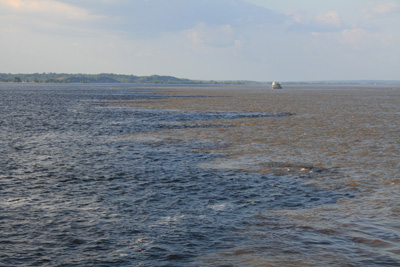
Meeting of the waters. Rio Negra and Rio Solimoes
Departure was delayed for some hours due to the volume of freight and it was a great feeling to finally cast off, heading to the line where the dark waters of the Rio Negra collided with the muddy waters of the Rio Solimoes. At this point it becomes the mighty Rio Amazonas meandering to the Eastern coast past Belem. Warnings abounded about the poor food quality on these journeys but our first meal (dinner) was excellent. Chicken, beans, rice, pasta and salad.
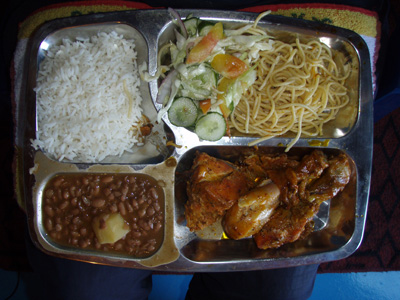
A meal for one! Excellent
The first thing noticed about this river was its size. Massive is the word for it but our vessel appeared to hug the bank for most of the time switching from one side to the other. Rubbish floating by is another sad feature. A cute little girl climbed the railing to our private deck with her mother watching closely. She returned and under the careful gaze of her mother promptly emptied the contents of a rubbish bin (plastic bottles, paper, foam plates and plastic cups) into the river. We witnessed dozens of people dumping rubbish into the river on our journey upstream. I wonder if this river will stop flowing because of the excess refuse clogging its mouth!!!

River houses

'Moon river wider than a mile.....'
The next few days passed so easily. Our comfortable quarters and good food combined with a very helpful steward made it a real pleasure. The hammocks hung on the deck near our cabin adding a lot of life and colour to the atmosphere. We sighted many birds in the early morning with the ever elusive pink dolphins making several appearances. They are difficult to photograph however as their surface time is very short compared to the ocean dolphins. The Amazon River reached a peak in mid 2009 not seen for 50+ years we have been told, but after peaking the level dropped dramatically to the point now where the river was very difficult to navigate. Huge erosion problems created numerous sand bars, floating trees and grass mats hampering navigation to the point where some ferries had shortened or cancelled their service.

Amazon village

River dolphin

Note the flood mark left on the tree trunks
Fishing appeared to dominate the lives of the Indians with dozens of boats sighted each day tending to small nets strung out close to the rivers banks. Fish glistened in the sun as they dragged in the nets and we believed when the foam floats submerged in the murky brown waters the nets were full of fish. Flimsy dugouts, some taking water, were powered by air cooled Honda engines sporting long propeller shafts. With the water lapping the top of the canoe they purred around the shore line collecting the flapping fish.

Fisherman pulling in his catch

Fresh Acai juice sales
The first leg of our journey, Manaus to Tabatinga was to last 4-5 days and the ferry stopped at many villages dropping off passengers and cargo. This occurred both day and night, however the stays were never long, ranging from a few minutes to 2-3 hours at most. On many occasions river dwellers pulled along side our boat to sell food stuffs and drinks. Just near Codajas, a very large settlement, a small powered boat pulled along side selling pure Acai juice. One litre for BRL4. Wonder what this would cost in the real world. We spoke to our steward who advised us to add a little açúcar (sugar). No dilution . muito bom (very good). Continuing up the river we could not help but notice that nearly all the housing had a TV satellite dish and often solar panels. There were few places with electricity out here, an extraordinary sight considering the standard of housing.

Many houses had satellite dishes

A river used for everything, washing dishes.
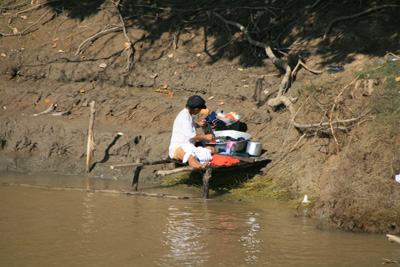
..washing clothes
Departing Manaus on the 2nd September, by the 6th we were looking forward to arriving in Tabatinga. At 8.00 pm on the 7th we docked at Tabatinga but there was only space for two boats and ours was number three. Double parking at the wharf a mass exodus of passengers and luggage crossed through the first moored boat onto the dock. The whole procedure took around 30 minutes and this left us almost the lone passengers. We would not leave until the bike was on the dock. The crew did not move and there were several discussions between the Captain and dock employees. Another 30 minutes and the engines started and we departed in the direction we had just come!! Around midnight the ferry docked at Benjamin Constant, more people disembarked, and we were informed that some cargo would be unloaded the next day, then we would return to Tabatinga in the hope there would be room at the wharf.
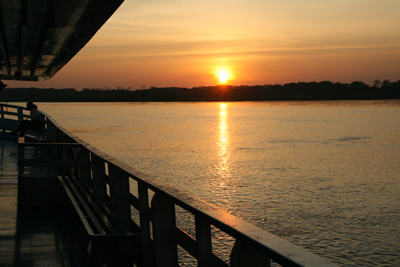
Sunrise

The view from our balcony
At 6.30 am cargo began to be unloaded and man power was the only means used, no wheels, until the boxes hit land. Unnoticed the night before, there was a river barge between us and the dock and our deck hands needed to cross this vessel with the cargo before stacking on the dock. This continued until mid afternoon when the barge departed and our ferry moored directly to the dock. The unloading was swift and the dock became clogged with bags of flour and rice plus hundreds of crates of soft drinks and beer. The second movement began with men loading trucks, 4x4s and three wheelers with tons of food and beverages. They seemed unperturbed about the heat and humidity, appearing to almost run the path occasionally stopping for a drink. Day one stopped at 10.00 pm. We were exhausted just watching.

Fish going to the market

The fish market

The fruit and vegetable markets
Unloading began again at 7.00 am. Our boat was rising in the water due to the volume of cargo being removed. Our patience was being stretched so we decided to go ashore and check out the local village after being assured the boat would not leave without us. We were the only passengers left on board, and food had stopped being served the day before. We stood out like spacemen on shore but there were plenty of things to see and do. Checked out the markets both fish and fresh produce. Purchased some bread, fruit and drinks plus ate a little street food. A change from the fare on the ferry and we were able to make it a quite spicy with the supplied fresh chili sauce.

BBQ fish
Returning, the couple running the café/bar on board had barbequed some fresh fish purchased at the fish markets. We joined them for a feast of bolo I think, a black, scaled fish that looked like a close relative of the cat fish. As we ate the workers were still unloading, this time it was boxes of chicken. While checking the bike we saw there were two motor vehicles on board previously buried behind the tons of cargo. Getting these off at the Tabatinga wharf would be interesting!!
At midday there was movement or should I say the movement stopped. The engines started and we cast off and headed back to Tabatinga. Benjamin Constant appeared to be on a tributary or maybe the Rio Solimoes had split into two creating an island but we appeared to head back to the main channel and motor west. Not far into a very wide section of the river our boat stopped abruptly when it struck a sand bar. The skipper revved the engines turning and pivoting trying to break free. The muddy bottom churned up violently as the engines protested their solid contact. Meanwhile the long boat attached to the side of the ferry took off with a depth rope to find a deeper channel. Finally after several minutes, the efforts of the captain worked and we motored on to Tabatinga arriving around 2.30 pm.

An easy offload, Tabatinga
The deck hands began work again unloading the remainder of the cargo. It was early and so we did not push for the unloading of the bike but we were constantly badgered by the local dockies to get their help. After our experience in Manaus we were determined not to get steam-rolled again. When the bike was starting to obstruct other cargo some local dockies along with the boats deck hands rolled the bike onto the first level of the wharf. This created our next problem as there was no ramp to the next level accessing the road off the dock however we stated emphatically that we would not pay for their services and would take care of the issue ourselves. We asked to borrow a plank from our ferry but were refused. A security officer asked what was the problem and he offered to assist. Fifteen minutes later a truck arrived with a plank and he arranged with the driver to place it securely and some truckies gave us a push to get it up to the next level. This took a matter of a few minutes and we did not have to pay ..this time ..!

Bike up to the next level, Tabatinga

Boat #1 Navio Sagrado Coracao de Jesus
After seven days on the ferry it was great to be back on the bike again. With the temporary import permit arranged for Tabatinga, we headed into the heart of town to the Tourist Office. It was here we met Dolly who was to be our translator, guide and helper in doing all things difficult for travelers not speaking sufficient Portugese or Spanish. Dolly rode a Yamaha scooter and she was kind enough to deliver us to an appropriate Hotel also including a short tour of her town showing us where the long boats were caught over to Santa Rosa, Peru. This was where we would catch our next ferry to Iquitos (Peru). Timetables for the ferries did not exist it appears, and so they arrived when they turned the last bend in the river and came into view. There was some communication with the vessels however and on Dollys recommendation we chose the Carlos Antonio to be our next ferry. ETA in Santa Rosa was unknown at this point but we could drop down to river to check if it had arrived if we so desired.

The Tourist Office in Tabatinga

Dolly, our helper in Tabatinga/Santa Rosa
We had several days in this isolated river city which shared borders with Colombia and the town of Leticia plus our destination town Santa Rosa in Peru. There were no restrictions in movements between Tabatinga and Leticia with the border appearing to be a bump in the road however one night when were taking Dolly out for dinner we were stopped by the Colombian Police. Dolly disappeared into the distance as we answered as best we could the Officers questions. Just as we were opening the back box for an inspection Dolly returned and explained our position. Laughs all around and a few photos.

The Carlos Antonio was a bit rougher compared to our last boat
On Saturday the 12th we had it on good authority that our boat Carlos Antonio would be arriving. Customs and Immigrations did not open on Saturday so we had checked out of Brazil the day before and were now illegals!!! Several ventures to the river, we returned with the bad news that our boat had not arrived. Frustrating stuff!!! Dollys grandmother was also travelling on this boat, returning to her home town of Iquitos so we were sure that if we kept with her we would not miss the boat. She was far calmer than us in this situation, obviously an experienced river traveller. Entering Peru it was necessary to complete our paperwork in Santa Rosa. I had done my immigration paperwork on the first excursion to Santa Rosa with Dolly however Carol was yet to complete her entry forms plus the Aduanes (Customs) papers for the bike needed to be completed. Carlos Antonio appeared around 3.00 pm so we scrambled to the shore line looking for our previously organized hired help to hustle the bike onto the long boat. They had disappeared and Dolly began negotiations with two other guys. They had sensed our urgency and the price increased. We could do nothing but pay the BRL60 as Dolly voiced her displeasure about the cost and the refusal of the helpers to negotiate or reduce the price. This sum was the equivalent to one night's accomodation for two including breakfast.

The task. Bike down to long boat, cross river, up mud bank onto boat #2. A few weeks earlier the river was lapping the road where we stood.

Boat #2 Carlos Antonio Tabatinga/Santa Rosa to Iquitos
Getting to the waters edge on the Brazilian side was easy .I just rode down through the mud. Our hired helpers were very happy. Less work for them but they earned their cash on the other side as they struggled to keep the bike upright through the mud and then onto the boat. Hard to believe we were in contact with another Australian who had crossed a few weeks earlier when the water level was lapping the road on the Tabatinga side.

Ken returning after processing bike papers at Santa Rosa

Saying good bye to Dolly, her mother and nephew
Before leaving Manaus I asked Joelmir what is the best river level for the ferries. High or low. After seeing the river and hearing tales of groundings, high is by far the best. No need to navigate through the sand bars, just scoot along the top taking the quickest line. Ahead we faced the prospect of running aground and some ferries had refused easterly routes due to the low river level.

Our small cabin

Floating houses

Sunrise
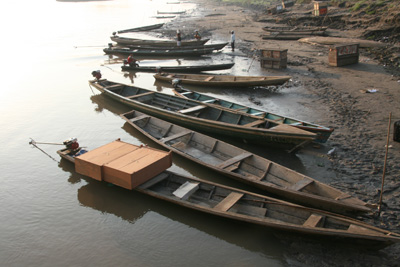
River life
By 6.00 pm all were aboard and we had adjourned to our cabin. This room was more of the style that we had expected. Double bunk with hardly enough room for our luggage. The bathroom/toilet on our first boat was bigger than this cabin. Very cozy. The community bathroom/toilets were at the stern and used river water for everything. There was no hot water but this was not necessary as the weather was so hot and humid. One good thing, the facilities were cleaned frequently. Dollys grandmother travelled hammock class and we greeted her several times as we walked around or visited the bathrooms. The hammocks were strung very close together and there was a lot of luggage strewn beneath them creating a real obstacle course traversing the length of the ferry.

Early morning stop
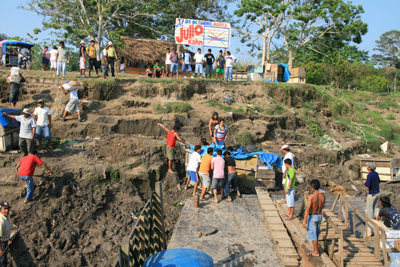
Loading cargo

Smiling toilet paper mover!!
The food standard dropped dramatically and was almost the same fare every meal. Stewed chicken plus a lot of rice cooked in river water although one day we had stewed beef and rice. As cabin dwellers we had our meals delivered to our room alleviating the pressure of queueing. Sadly, all meals were served on disposable plates and most of these ended up in the river (not by us). There was no ventilation in our quarters so many hours were spent sitting just outside the cabin door, sometimes well into the night, enjoying the cool breeze. Often we would pass other ferries, and on one occasion around midnight, a 200ltr drum of fuel was passed by our boat to another ferry but somehow it slipped into the river disappearing into the darkness of the Amazon. Piercing spotlights located the runaway drum eventually being retrieved by a pursuing dinghy from the other vessel. Quite a show as ropes were tied around the errant drum and dragged onto the drifting ferry.

Packing fish with ice and rice husks

Going

Going
.

Gone!!!
This ferry ride was the shortest however the most interesting. Fish packed in ice and rice husks were transported in old refrigerators, laid on their back with wooden crates built around them. They must have weighed a ton or more and were manhandled onto the nose of our vessel. The precarious loading procedures caused many dramas as some attempts failed as the crates crashed down the slippery, muddy banks or off the flimsy wooden planks. Delays of several hours occurred as they rescued the fish and repacked the container with more ice and rice husks.

Cooling in the breeze outside the cabin

Another box of fish to be loaded on the boat

Successful landing!!!

The next, not so lucky, sliding off the deck into the mud
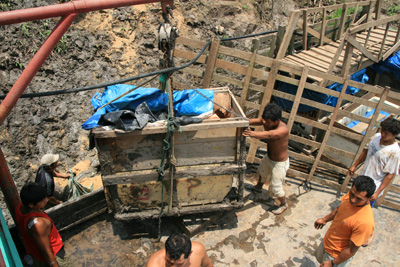
A boom plus block and tackle was finally used to rescue it from the mud
Our ferry also took livestock. A number of pick-ups from villages saw a total of 40 pigs (phew), 4 bulls, 2 ducks, 6 chickens, 1 parrot, 1 monkey, 1 dog, and 1 cat. The pigs were stationed just below our cabin and even the Captain struggled with the smell. They squealed and fought over food and generally suffered in the Peruvian sun. A hose was used to wet them down periodically but the respite was short-lived and the squabbling returned. Night time was much better but the smell must have been so extreme down below as most of the crew sat or slept on the bow of the boat. The bulls were housed with the other cargo under cover with our bike. No doubt there would have been waste and odour issues down there as well.

Loaded and on our way.

The first of the pigs are brought on board

More fish

More pigs

Local housing
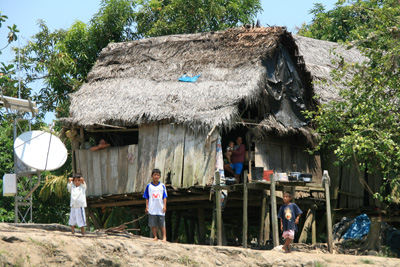
Local housing
Carlos Antonio departed Santa Rosa/Tabatinga 8.00 pm on Saturday and arrived at Iquitos Tuesday at 6.20 am. Iquitos was very busy and quite dirty to the point we thought we were in India. People scrambled onto the boat and the deck hands began distributing the fish directly from the crates into plastic bags which were subsequently weighed and paid for . chaos. During the pandemonium, some men approached us about unloading the bike. No rush for us though, the entertainment in front of our cabin had us enthralled. While the fish sales were in full swing a couple of the deck hands decided to release the pigs. The squealing, pushing, frantic animals raced up the bank reveling in eating and digging through the rubbish on the bank. Amidst this confusion the four bulls were dragged through the pressing crowd of fish buyers up onto the shore.

Amazon village

Village housing
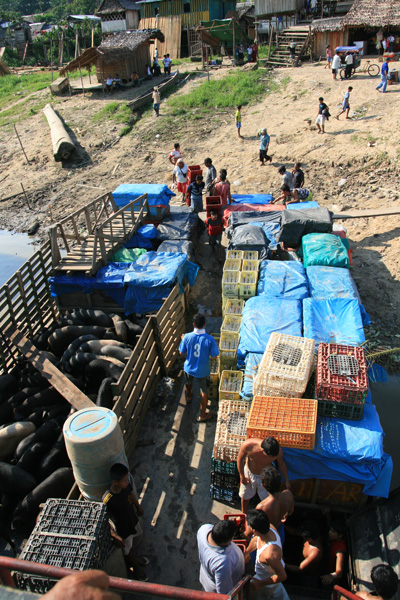
Fish, pigs, chickens, the boat is full!!

Another part of the village

Hammock life

The much cooler top deck was not as crowded as the middle one

Rice growing, suffering from erosion in the record high water

Huge erosion problems

Another lovely sunset

Iquitos in the distance
It was time for the bike. Entering the covered cargo hold the stench was a little strong to say the least. Damage to the fairing revealed the bike had been moved from its original position and dropped at some point, just a little paint though. Hands appeared from all directions.. a hand on the back box meant they helped unload thus entitling them to payment. Carol did her best to keep them away from the bike as I wheeled through the throngs of people with the horn and siren screaming for clear passage. Reaching the end of the boat two planks were positioned and I quickly disembarked leaving our helpers on the boat. During the drama assisting hands that were on the bike almost pushed me off the board, and I screamed at them to leave the bike alone. On terra firma I started the bike and rode up the bank with no assistance and subsequently we made no offer of payment for any unsolicited help.

Chaos on the banks at Iquitos

Chaos on the boat!!

Releasing the pigs

The fish is sold straight from the ice boxes

Pigs causing havoc on the bank
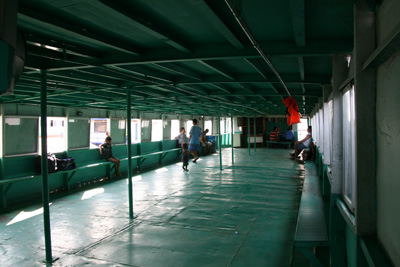
The hammocks are down

Time to get the bike

Getting the bike through the crowd

Down the plank and up the bank

Fish sellers
Before all this procedure we had arranged with the local Aduane to ride to a nearby office and arrange a temporary import permit for the bike. The paper work took around an hour and all was very pleasant other than the sweltering heat and humidity. A sticker was placed on the screen giving us several days grace in Iquitos to arrange another boat enabling the continuance of our journey to Yurimaguas. Returning to the ferry to collect Carol and the luggage we rode into the city. Three wheel taxis dominated the streets and proved to be the preferred transport of locals and offers of Hotels came from several people as we tried to find the tourist office. Only a few metres from the office we booked into La Taberna del Cauchero a grand place with views near the river and bike parking in the reception area. A tropical downpour caught us in the afternoon and cooled the air well into the evening.

Three wheeled Taxis and a tropical downpour in Iquitos

Wooden housing

Exclusive parking in the foyer of our hotel

Iquitos traffic
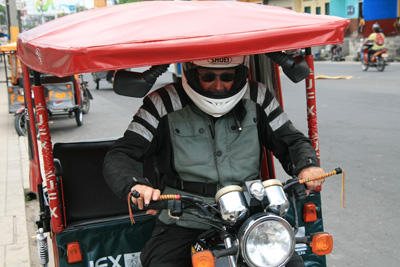
Kens new bike!!
The following day our English speaking tourist adviser gave us the name of a likely ferry departing in a couple of days. Paid for the pleasure of a 3 wheeled taxi to the port or should I say river bank and arranged our cabin plus bike shipping on the Eduardo which departed 5.30 pm the next day (Thursday). Arriving just after midday we were surrounded by several men wanting to assist us in the loading. Investigation revealed that this would be an easy one when one of the deckhands placed another plank beside the existing one allowing me to walk the bike onto the boat. The ever present hands appeared and once again almost caused me to toppled off the planks. On board two men followed us to our cabin demanding money despite our insistence that we would not pay as we did NOT require their dubious assistance. As we argued the boats deckhands toiled away in the midday sun loading tons of cargo into the hold and I wondered what remuneration they received for their hard labour. Certainly much less than the princely amounts being demanded by our unnecessary help.
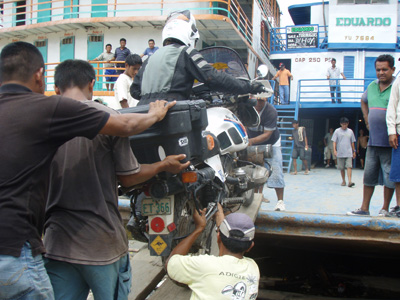
One more embark, Eduardo boat #3

Rubbish is a huge problem

Stalls line the entry to our ferry
Night came and the cargo loading continued. Passengers that had boarded in the afternoon with us left the boat and by 10.00 pm there were few people left. Obviously some problems with the cargo so we presumed departure would occur the following day. Our cabin this time had two double deck bunks thus allowing us to spread out a little. We had received assurances that we would be the only people in the cabin despite the four bunks. Early the following day loading commenced again and continued to late into the afternoon. The grand finale was the construction of a large wooden crate lined with plastic and subsequently filled with ice and fish. Just on dusk a huge influx of people crammed onto the boat. Hammock space was limited even then but somehow more were squeezed onto the already overcrowded boat with their personal possessions scattered on the deck beneath their temporary bed. Carol ventured away to take more photos of the chaos when I was approached by a man (who we later found out to be the Captain) requesting that two more people be allowed into our cabin. My protests went unheeded as he demanded I open the door which revealed our overabundance of luggage and lack of space. Unperturbed he proceeded to allow another couple with almost as much luggage to enter the cabin. I blocked the door way and requested the cost of the other two bunks and said I will pay. He quickly left the scene returning with the ticket seller who subsequently relieved me of the appropriate sum.

Village, Iquitos to Yurimaguas

Another port
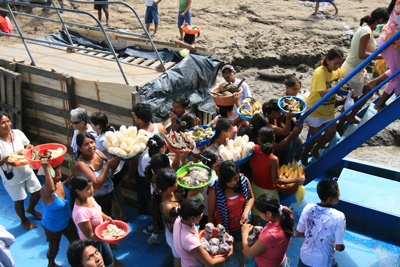
Food sellers board the boat when we stop
We departed the fair city of Iquitos at around 6.00 pm and just after dark we were befriended by a teenage student who spoke English and relayed to us what had just happened. Our delayed boat had been inundated by at least another 240 passengers almost doubling the legal quota of around 250. Of this number 200 were students returning from an athletics carnival in Iquitos. They were originally to return the following day (Saturday) but our delayed vessel allowed them to catch this earlier ferry thus they were able to get home sooner. Needless to say the pressure on all facilities was extreme and the conditions were really very bad. Being cabin dwellers gave us certain privileges however, one being we could sit at a table to eat (near the galley) without queueing for our meals which was an extraordinary procedure to say the least. Dealing with 450 + people queueing amongst the hundreds of hammocks on such a small vessel was almost unmanageable. Our English speaking student joined us at the table on a couple of occasions and drank some of our fresh fruit juice also reserved for cabin dwellers. The lady of the kitchen took a dim view of this and chased him away remonstrating that this liquid was exclusive to cabin folks.

The only two luxury boats we saw in Peru

Villagers waiting for disembarking family
The journey was a veritable milk run with frequent stops to load and unload freight plus people. Food was of similar standard as the previous vessel and despite our fears we were not affected. River water was used for everything, including cooking, showers and toilets the colour of which had not changed since we started the journey in Brazil Muddy brown. Our drinking water was previously purchased bottled water.

River water is used for everything

We had pigs they have chickens!!

Village life
After departing Iquitos on Friday evening we were surprised to hear the buzz of we will be in Yurimaguas early next morning (Monday) but the excitement of the journey was not yet over. Around 4.00 am I was jolted out of a deep slumber by our vessel hitting a sand bank. Staggering out of the cabin I saw several hammock dwellers fitting life jackets. How serious was this???? We seemed to be still moving and there was no apparent listing. The collision was not big and the ferry must have bounced off the sand bar and back into the main current. The often used spotlight came back to life as the crew scanned for more possible thumps that really upset paying passengers. Avoiding several sand bars the vessel almost ran aground again with the propellers churning the silted river bottom into a dark grey, frothy soup as the Captain struggled to gain clear water. Success at last and we joined other relieved passengers impatiently searching ahead for our intended landing spot.

The port at Yurimaguas
Our experience getting the bike off in Yurimaguas was by far the easiest as we firmly stated to the resident' dockies' that we could do the disembarking ourselves and absolutely no money would be paid. The other benefit was the bank where we were moored was easier to negotiate than many of the others although the pushing and shoving during the early part of the exercise was a little disconcerting. The traffic was more intense here than Iquitos however we found a comfortable Hotel/restaurant with secure parking very easily. Our tri ferry Amazon journey had come to an end after a total of 20 days including several lay days in Tabatinga and Iquitos while waiting for continuing vessels.

Dried fish

Downtown Yurimaguas

Our hotel

Village on the way to Tarapoto

Yippeeeee!! New paved road had only opened the month before

Loaded up!!
We had already been advised that the road out of Yurimaguas to Tarapoto was recently paved and what a pleasure it was to glide over this smooth surface with new tyres. Depleted funds the ATM in Tarapoto was tapped and we headed into the mountains of Peru towards Pedro Ruiz. What a fantastic day of riding, probably enjoyed more because we had been cooped up on river boats for so long. The twisting roads, green vegetation, the fresh air and perhaps a much cooler climate made this day one of the most appreciated rides of the past months. The small amount of rough road works, stop/go signs and one laned detours failed to dampen the enjoyment and arrival in Pedro Ruiz just on dark heightened our expectations that Peru was going to be a great ride.
Discussions along the way Carol recalled that Jeff from Norton Rats Tavern in Cusco was building a new house between Pedro Ruiz and Chachapoyos so a little more research we detoured up a small dirt track into the mountains. Jeff was working hard and it was a pity to disturb him .I do not think he minded though. We shared a few stories and lunch and vowed to meet him in Cusco for a little social interaction.

Great road to Tarapoto

Beautiful

Road works on the way to Pedro Ruiz

Even the new roads had problems

Beautiful mountain scenery

Pedro Ruiz
Chachapoyas was a hub for tourism with tours offering any number of excursions into the countryside. Our favoured trip was the one to Kuelap, Chachapoyas/Inca ruins of some significance in Peru and despite our recent lengthy boat ride decided to enjoy a ride in a mini bus through the mountains to their location. How sorry were we??? The driver appeared to not know the way and was often given instructions by our guide on where to go. The speed at which he traveled also left much to be desired and the chance of taking a photo of the spectacular scenery along the steep mountain road was nigh on impossible. After striking my head on the roof two or three times I decided to brace myself a little better expecting the rear of the vehicle to slide over the edge of the Peruvian death road. Speaking with other passengers (mostly German) we were informed that this was normal driving practice in Peru. I found this hard to believe as they gripped the seat in front and the hand rail above their heads with very white knuckles. Our arrival back at the Hotel was said to be around 5 to 5.30 pm. I believe we arrived closer to 4.00 pm indicating the unnecessary speed at which we travelled.

Mountain scenery

Wet road from passing shower.

Overhanging cliffs

A hard walk through the clouds at 3000m

Entrance to Kuelap

Massive stone walls

Narrow entrance

Kuelap

House foundations. Great view

Small house ruins

Patterned walls

Kuelap walls
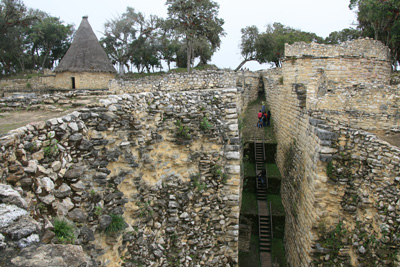
Another narrow entrance for defensive purposes.
Only a 100km day today to Leymebamba along a well formed dirt road beside a picturesque river. The short ride allowed us to visit the local museum recommended in our guide book and also along the way enjoyed the colour and vibe of local markets at Yerbabuenba. The museum was excellent and displayed a number of mummies from the region. No photos were allowed however.

Plaza de Armas, Chachapoyas

The road to Leymebamba

Lively street markets Yerbabuena

Road outside of Leymebamba
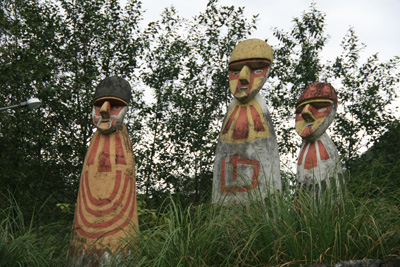
Statues, museum near Leymebamba

Museum

Narrow road

The plaza in Leymebamba

The road to Balsas

Up in the clouds at around 3680m

Small landslides were common.

Tight squeeze

Thats our road ahead
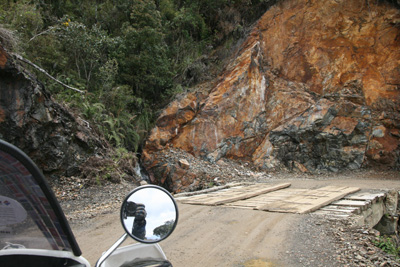
Many little wooden bridges

Down one side and up the other

Our road snaking down the mountains
Climbing out of the valley we enjoyed the twisting mountain road through the area called the Cloud Forest to Cajamarca. At 3500 metres the bike was running very badly, appearing only to be running on one cylinder and stalling at every opportunity. The right side was not firing and clouds of black smoke belched out the exhaust when revved. The dirt road offered all types of riding as we climbed up into the clouds then dipped down into valleys tropical enough to grow mangoes. Spectacular!!!! We arrived at 5.30 pm quite despondent despite riding some of the most beautiful roads and scenery and then had difficulty finding central accommodation with parking. Many Hotels and hostels were booked out. Hotel Cajamarca just off the main Plaza came to the rescue as we parked the bike in a pleasant courtyard. The next day we located a garage where we tried to diagnose the problem. We replaced spark plugs, leads and carburetor bits to no avail and thus expected it to be the coil as the right spark appeared a weak yellow, far from the blue spark on the left side. Emails were sent and a post was made on Horizons Unlimited asking for help. Most people agreed with the determination that it was a failed or weak coil. What do we do next??? A number of options opened up all we had to do was choose.

Narrow road

Spectacular!

Thats our road on the other side of the valley

It was a cliff hanging experience

Crossing the Rio Maranon at Balsas

Our own little death road in Peru

Road works near Cajamarca

Oversized load
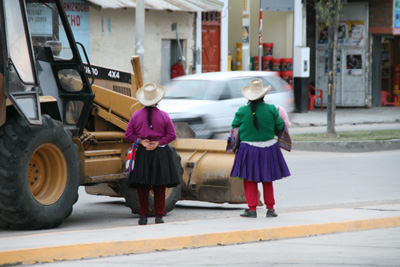
Women in Cajamarca
But first we would get a second opinion from a mechanic offered to us by some English chaps who ran a motorcycle tour company out of Cajamarca.
